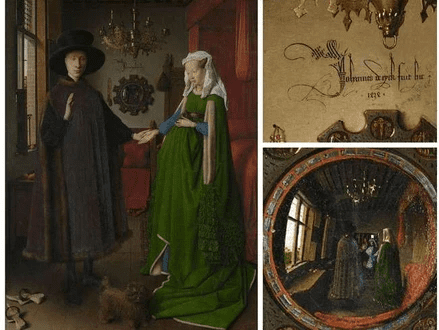When we think of art, the first thing that pops into our heads isn’t hidden meanings, and symbols within art. But despite this, many artists have hidden certain ‘easter eggs’ within their art, many of these artworks have become very famous over the years, and many of these hidden symbols with paintings were created during the Renaissance.
So I’m here to tell you all about the 10 best symbols and codes that are hidden within Renaissance art that I’m sure you may have missed the first time you saw them.
1. Jan van Eyck: The Arnolfini Portrait (1434)

You’ll notice some writing on the wall (top right) and a little mirror in the backdrop of The Arnolfini Portrait if you look attentively (bottom right).
The lettering reads “Jan van Eyck was here 1434,” implying that the artist is “tagging” his own painting’s wall. Furthermore, if you look in the mirror, you’ll find — and this is only visible with a magnifying glass and a physical copy — that van Eyck managed to paint a very precise reflection of the scene in the mirror, including what looks to be a little self-portrait.
One contentious argument for van Eyck’s “tagging” is that the painting was intended as a formal document of the marriage of the couple shown, Giovanni di Nicolao Arnolfini and his wife, and van Eyck wrote his name as a witness to the marriage.
2. Hans Holbein the Younger: The Ambassadors (1533)

An antique picture with a concealed skull, revealed only as you up the stairs, sounds like something out of a corny haunted home. But that is precisely what is happening in The Ambassadors. It’s called anamorphosis, and it’s a visual trick in which an artist creates a deformed picture that may be “reconstituted” if viewed from the appropriate angle. Notice the unusual smudge of white and black on the titular ambassadors’ feet? The picture on the right shows how it appears when seen “correctly.”
eerie! Scholars are perplexed as to why Holbein included this little illusion. Some speculate that he was simply strutting his stuff.
3. Michelangelo: Zechariah (1508-1512)

For his book The Sistine Secrets: Michelangelo’s Forbidden Messages in the Heart of the Vatican, author and Vatican expert Roy Dolinger spent six years researching Michelangelo’s work on the ceiling of the Sistine Chapel and uncovered some fascinating findings. Behind the back of the prophet Zechariah was a putti (little angel) “making the fig”—sticking your thumb between your index and middle fingers, the Renaissance equivalent of flicking someone off.
What is the reason behind this? Michelangelo based Zechariah on Pope Julius II, often known as Il Papa Terribile, the Fearsome Pope, at the time. Dolinger claims that it was Michelangelo’s means of subtly offending the Pope. The move is so slight that it would be difficult to see from the ground, which is the only way Il Papa Terribile could have seen it.
4. Pieter Bruegel the Elder: Netherlandish Proverbs (1559)

The Book of Proverbs in the Netherlands is simply a gigantic game of Where’s Waldo? instead of… whatever Waldo was intended to be, with concrete instances of Danish proverbs and idioms It’s lots of little images of peasants behaving badly, but if you look attentively, each one represents a proverb.
Some, like “Killing two flies with one stroke,” are still in use today (though in significantly changed versions).” However, some are somewhat esoteric, such as “They both crap down the same hole,” for example “They’re “inseparable pals,” as the phrase goes. The 112 proverbs included in the picture are well-explained in the Wikipedia entry for The Netherlandish Proverbs. Scholars believe Bruegel may have secreted many more paintings that have yet to be discovered.
5. Leonardo da Vinci: The Last Supper (1498)

Google created the highest-resolution scan of da Vinci’s The Last Supper at 1 billion pixels using an Art Camera and made it available online. The scan, which is really the closest authentic replica of da Vinci’s work, was developed by Google Arts & Culture in collaboration with England’s Royal Academy of Arts. It is considered to have been made by his pupils Giampietrino and Giovanni Antonio Boltraffio.
Art historians found certain crucial elements buried in the Giampietrino and Boltraffio copies with the enhanced resolution. Spilt salt is found next to Judas’ right arm, which is regarded to be a terrible omen. Also, Peter is clutching a knife, which might be a hint that he would try to halt Jesus’ arrest by chopping off a soldier’s ear.
Leonardo da Vinci’s The Last Supper is a late 15th-century fresco painting in the refectory of the Convent of Santa Maria Delle Grazie in Milan. It is one of the most well-known paintings in the world, as well as one of the most researched, dissected, and satirised. The work was commissioned as part of a programme of improvements to the church and associated convent buildings by Leonardo’s patron Ludovico Sforza, Duke of Milan, and is thought to have begun in 1495. The Last Supper of Jesus with his disciples, as described in John’s Gospel, 13:21, is depicted in the picture. When Jesus told the Twelve Disciples that one of them would betray him, Leonardo showed their disbelief.
All About The High Renaissance
6. Caravaggio: The Supper at Emmaus (1601)

At first view, the Supper at Emmaus looks to be a very simple scene: a group of men dining around a tiny table in a dark room. The men encircling the primary figure appear emotional, however the centre person—who appears to be Jesus Christ with a close shave—appears calm and unflappable, indicating wisely with his right hand. What the hell is going on here? Are there any hints tucked away? Although there is a dish of fruit, isn’t Jesus more of a fish and bread guy?
What is that shadow on the table, though? Is it a fishtail, or what? Yes, the picture depicts a resurrected Jesus meeting with his apostles before unexpectedly departing. Caravaggio left numerous “clues” in this late-Renaissance masterwork, including the fishtail.
7. Angolo Bronzino: An Allegory with Venus and Cupid (1545)

In the Journal of the Royal Society of Medicine, Christopher Cook contends that An Allegory with Venus and Cupid is truly about syphilis. He claims that nearly every aspect shows that the piece’s true “lesson” is that “unchaste love brings not only joy and pleasure, but also painful consequences.” The thorn penetrating the tiny child’s foot close to Venus is only one piece of disturbing evidence to back this assertion. Perhaps as a representation for “syphilitic myelopathy and nerve damage,” the youngster is “foolishly indifferent to the damage.”
Regardless of Bronzino’s intentions with the artwork, there’s one hidden part that’s terrifying to see:
The young girl is a monster in disguise.
8. Michelangelo: The Creation of Adam (1511-1512)

The Creation of Adam, Michelangelo’s renowned image on the ceiling of the Sistine Chapel, depicting God in his nightgown reaching out to touch Adam’s finger, is well-known. Have you ever pondered what goes on behind God’s scenes? Why is there such an odd clump of cherubs? What does this imply?
The most likely explanation, according to art experts, is that Michelangelo, who had previously dissected human corpses, intended the form to resemble a huge brain. It’s a powerful argument, especially when you look at the illustrations that show the parallels.
9. Caravaggio: Bacchus (1597)

The painting of Caravaggio Bacchus is depicted with a large glass of wine, a dish of fruit, a relaxed Dionysus in a toga, and a miniature artist drowning in a carafe, as you’d expect in a depiction of the Greek god of wine. What’s going on here?
Is he visible to you? It’s difficult to shoot well, but art restoration specialists say it’s Caravaggio around the age of 25. A restorer washing the picture initially noticed Caravaggio in 1922, but “poor restoration efforts” in the years that followed made him almost undetectable. Researchers employed a technology called reflectography in 2009 to get a glimpse of Caravaggio’s miniature self-portrait as he meant it. He looks to be a reflection on the carafe, “with an arm held out towards a canvas on an easel,” rather than being within the carafe.
10. Hans Holbein: Portrait of a Lady, (Circa 1540)

Henry VIII’s fifth wife, Catherine Howard, was considered to be shown in a miniature picture made by Hans Holbein, Henry VIII’s court painter, for a long time. However, art historian Franny Moyle stated in 2021 that the evidence she discovered believes the picture depicts Anne of Cleves, Henry VIII’s fourth wife.
According to Moyle, Holbein put the miniature picture on a playing card, maybe the fourth queen, the four of diamonds. Other miniatures by Holbein were put on playing cards with similar connotations, such as a picture of a new wife on an ace-of-hearts card. “So the four of diamonds is arguably significant,” said Moyle. “If it had been the three of hearts, I would have been furious.”
The necklace worn in the photo, passed down from Henry’s third wife, Jane Seymour, led to the assumption that the painting was of Catherine Howard. “When Henry divorced one of his wives, he had a tendency of passing on their possessions to their heirs. As a result, the argument that it is Jane Seymour’s jewellery also applies to identifying Anne of Cleves “The Guardian quoted Moyle as saying. Moyle also noticed that the face of the figure in the picture resembled Holbein’s 1539 picture of Anne, which had heavy eyelids and brows.
Information Citations
En.wikipedia.org, https://en.wikipedia.org/.
Recommend0 recommendationsPublished in Art History, Resources


Responses